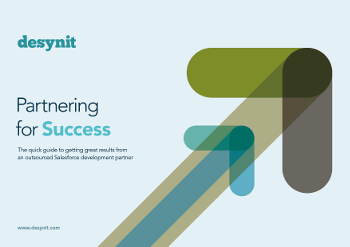
Every Salesforce implementation is unique, that’s a given. If it worked the same for every business, there would be no need for an implementation partner.
Having said that, there is one universal factor that applies to all businesses looking to get started on Salesforce for the first time: everyone wants the best start possible for their business on the platform. So, assuming that:-
- You are committed to Salesforce (and here’s why you should)
- The business case is signed off
The question you probably need answered is…
…How does a Salesforce implementation project work?
The fact is, although the final system will be unique to you, the process you need to go through to get to that is well defined. Here’s what happens…
First contact with a Salesforce Implementation Partner
The best place to find a implementation (or ‘consulting’) partner is by taking a look on the AppExchange, the Salesforce products & services marketplace. You can also ask for word of mouth recommendations from your own network. There should be an intro phone call at that point, possibly a meeting, and a chance to describe your needs. You should also get an idea of what kind of budget you will need for the project.
Pre-engagement questionnaire
If everyone is happy at that stage, your implementation partner should send over a pre-engagement questionnaire. This is a chance for you to describe the big picture e.g.
- What is your vision? Goals?
- What are your pain points?
- Who are the key players?
A note on key players
The most important person on an implementation project is the Project Champion, and this should be someone who works for you, not for the implementation partner. They will be the person overseeing the process, acting as a liaison between your team and theirs, and making sure all the deliverables are in place at project close. This is not a technical role.
Agree a date
Based on the questionnaire, there are a likely to be a few more questions from both sides. Again this can be done face to face, or over the phone. You may need your consulting partner to present a demo to other stakeholders in your business. Once everyone is happy, this is the time for your partner to send over a contract, and book a date for the implementation.
The Plan
First day on site, the implementation partner and your team will work closely together to produce a project brief and plan. This will define the baselines and include all success criteria against measurable targets (e.g. cost/ risk/ scope/ time/ scope/ benefits)
In practice, this is done via another questionnaire, but this time, much more detail is required. Some question examples would be:-
- What key characteristics do you use to profile or segment your customers?
- What materials do you send to customers during the sales cycle? List the 5–10 documents you use most frequently.
And so on. It’s this exercise that gets you to a full project brief and plan. Once your Project Champion has sign off on this document from all the necessary personnel from the business, it’s time to get to work.
The Build
Your implementation partner may do the development work onsite, or remotely. That’s something you can agree with them. During this configurement and development stage, your Project Champion should be able to clearly evaluate project milestones.
Training
Once your Project Champion is happy that all the planned deliverables are in place, it’s onto the training stage.
Never overlook the importance of training your users. Any implementation partner worth their salt will understand how critical user adoption is, within the Salesforce roll out process, and take it just as seriously as the build itself.
Support
Finally, the project plan has been delivered, your users are able to get to work on their new platform, after being trained. So that’s it?
Not quite.
Your system will need some level of ongoing support. As part of our Best Start package, we include a 2 week free trial of our support service. The level of support you are going to need from there on in will depend on a number of factors, the two key factors being:-
- How many users do you have in your business, and..
- Do you have any in-house Salesforce expertise?
To keep getting the value for money out of this platform, you will need expertise to support it, and one of the best ways to do this, is with the trusted consulting partner that built the system for you in the first place.
If you have more than 30 users, is definitely worth thinking about getting a full-time Salesforce administrator to work in-house, on your team.
Post-implementation
The real beauty of Salesforce as a system, is that it’s going to grow with your business. You know that whatever direction you take, you can rely on this platform to accommodate your future IT requirements.
Businesses often have the next steps in mind, to move onto right after the initial implementation. There’s also no harm at all in the suck it and see approach, before making any decisions immediately about what to do next.
The point is though, without sounding too cliched, is that working on Salesforce is a journey, and there is really no such thing as an implementation end point. The important thing is that with a good partner, you should be fully in control of each stage and have a clear understanding of where you are on the roadmap.


Thanks for sharing the valuable post!!